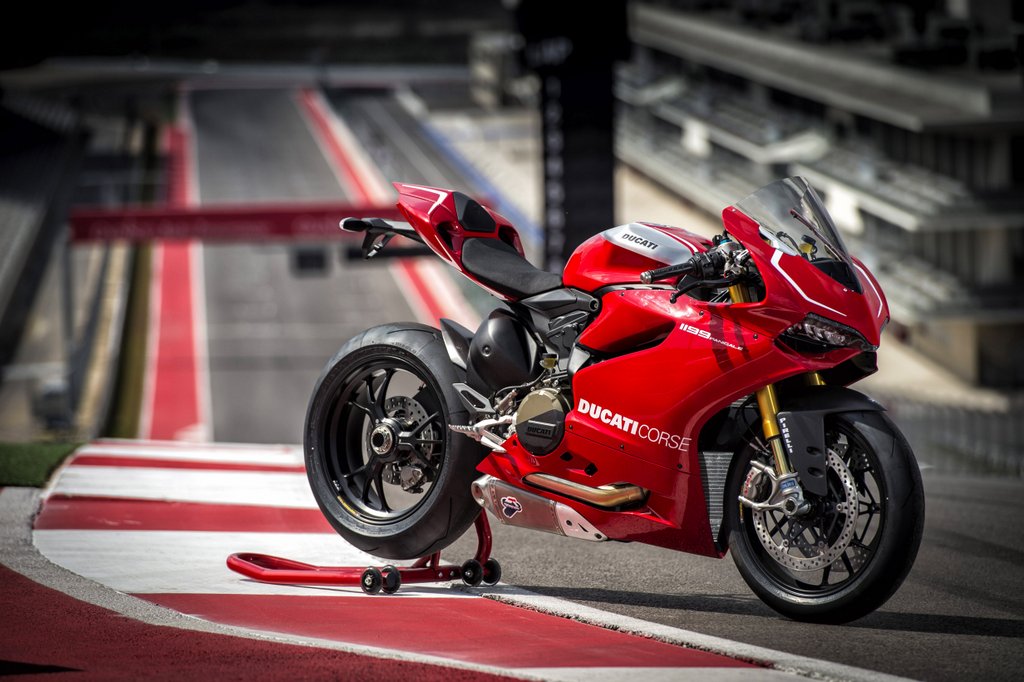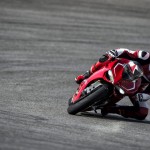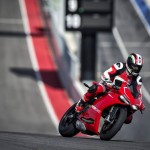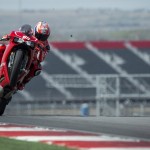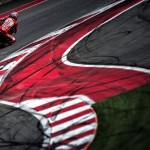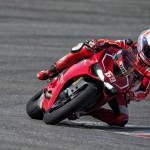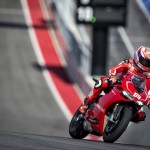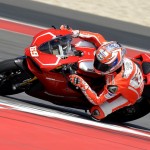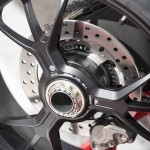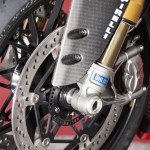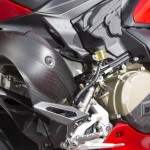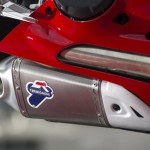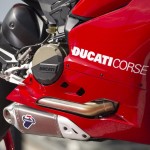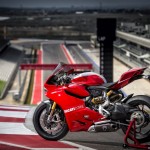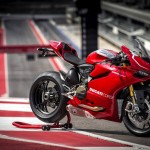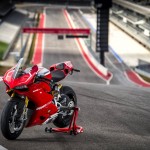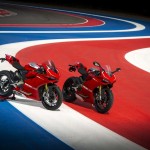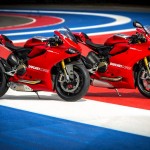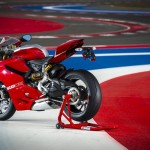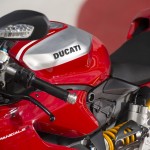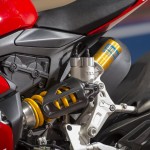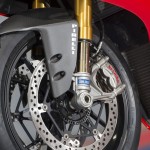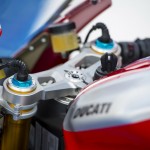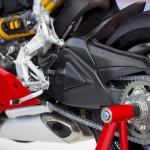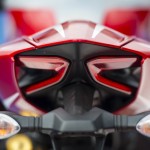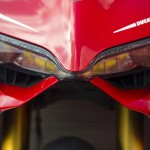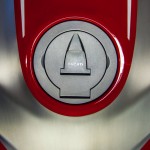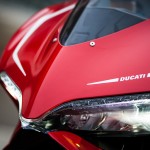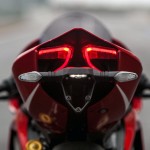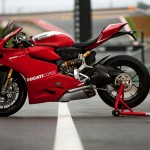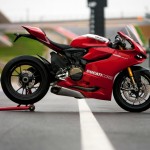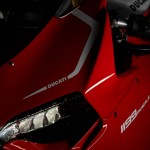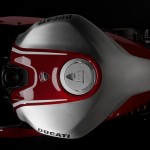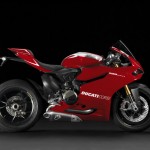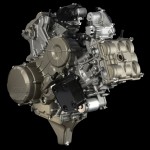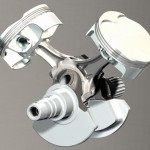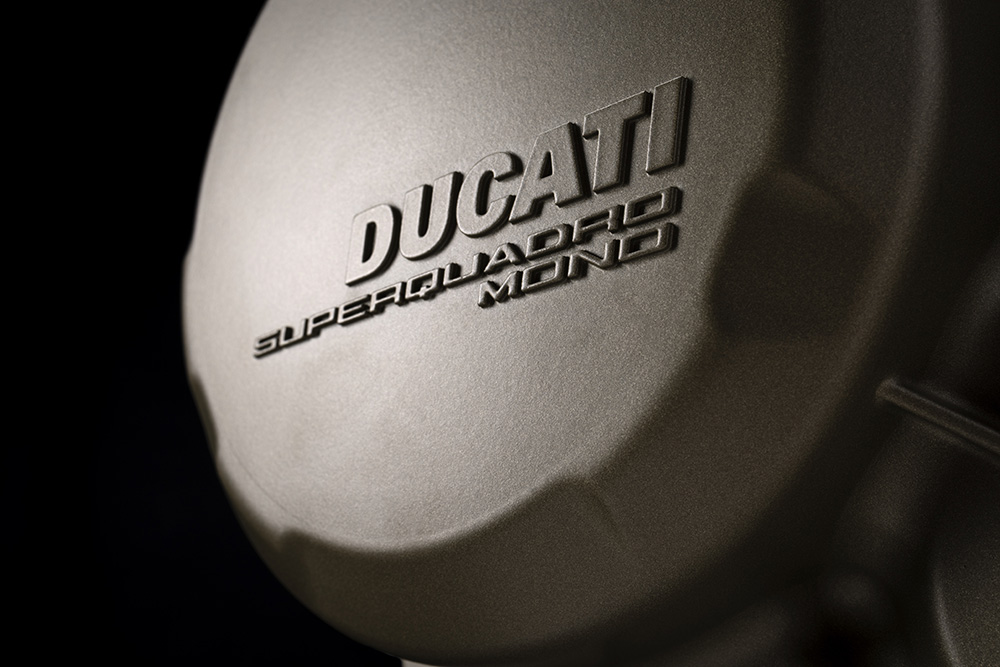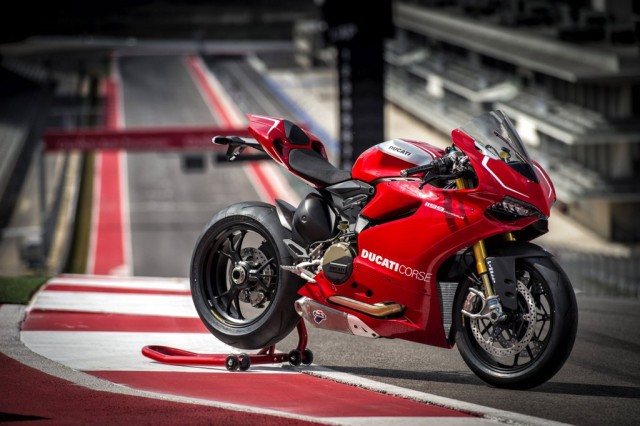
The pursuit of perfection
The 2013 Ducati Superbike family now presents the highly-anticipated 1199 Panigale R, the absolute flagship of the range and the machine specially developed with enhanced technical specification by Ducati Corse for World Superbike homologation. Its design includes a number of specially developed components intended for connoisseurs of performance and, as part of an ongoing initiative of reacting immediately to owner feed-back, its arrival introduces a series of enhancements throughout the 1199 range. These enhancements include improved heat protection for the rider and latest generation engine management mapping and Ride-by-Wire calibration.
The “R” takes everything the formidable “S” model iscurrently equipped with, including top-of-the-range Öhlins electronic suspension, and applies a list of enhancements that enable the model to achieve even greater targets. While the chassis now sports an adjustable swingarm pivot position and numerous
weight-saving components in carbon fibre, the engine adopts titanium con-rods, which save an overall 0.63kg (1.38lb), a 0.7kg (1.54lb) lighter crankshaft flywheel and DLC-coated rocker-arms. These engine modifications now enhance the Superquadro crank acceleration and allow it to rev 500rpm higher to a new 12,000rpm limit, an incredible engineering achievementfor 112mm pistons. The higher limit has also enabled the model’s final drive to use a 41 tooth rear sprocket (39 on the standard and “S” version), effectively delivery more torque to the rear wheel without compromising top-end speed. The famous “R” race kit components consist of high-penetration racing screen, fairing mirror caps in machined alloy and a full Termignoni exhaust system with dedicated ECU mapping (for track use only). The system provides an impressive power increase of 3% at the top of the rev-range and 15% in the mid-range. The race-oriented “R” model also features a 4-point adjustable swingarm pivot, designed to enable riders a personalised and precise set-up of varying levels of pro or anti-squat to optimise traction on corner exit. The settings are dialled-in using two user-friendly eccentric adjusters that offer pivot positions at +2mm higher, -2mm lower and -4mm lower than the standard position, each positively and accurately locked and located. The clearly marked, easy-to-use system provides optimum adjustability for competition use. Additional enhancements to the machine include lightweight carbon fibre rear hugger, rear suspension
guard, heels guards, ignition switch surround and top fairing inner panels and carbon fibre protectors for the single-sided swingarm and clutch cover. These lightweight chassis and engine components enable the “R” version a dry weight of just 165kg (363.7lb), even with an ABS braking system fitted as standard equipment.
This top-of-the-range model is also fitted with a special race-style seat fabric for added “feel” and equipped
with the GPS-enhanced Ducati Data Acquisition system, for automatic lap times and circuit map-linked data.
The 1199 Panigale R is dressed in Ducati red with defining white race features and sporting a mix of red and
brushed aluminium on the fuel tank. “Ducati Corse” graphics in white proudly decorate the fairing side
panels with Ducati Corse logos mounted also on fuel tank top and front fender.
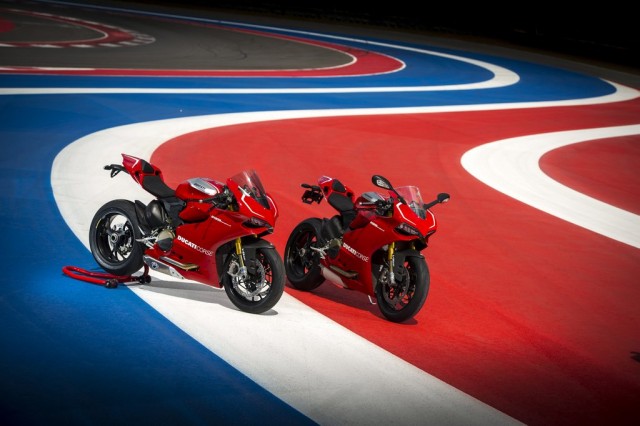 Extreme benchmark
Extreme benchmark
Ducati’s latest generation Superbike, the 1199 Panigale, goes beyond the barriers of motorcycle design and
engineering to set the most extreme benchmark ever and the direction for future sport bikes. Developed in
the red-hot environment of racing and designed to raise the performance bar to its highest, the 1199
Panigale uses innovative Ducati Corse-derived solutions to make World Championship level technology
available to everyone.
The most high tech, most powerful twin-cylinder production engine on the planet is now an integral part of
an innovative monocoque chassis that combine to deliver an astonishing 195hp from 165kg* (363.7lb) of
futuristic Italian thoroughbred. The highest production motorcycle power-to-weight and torque-to-weight
ratios in the world are fitting trophies for the incredible results that Ducati have achieved.
With the click of a button, Ducati’s Riding Mode concept delivers performance with enhanced rider
confidence by combining seven class-leading technologies. The latest-generation sports ABS system,
Ducati Traction Control (DTC), Ducati Electronic Suspension (DES), Ducati Quick-Shift (DQS), Ducati’s
race-derived Engine Brake Control (EBC) and Ride-by-Wire (RbW) are now all programmed into seamless,
electronic rider assistance. Even the full colour Thin Film Transistor (TFT) display changes to suit the rider’s
environment.
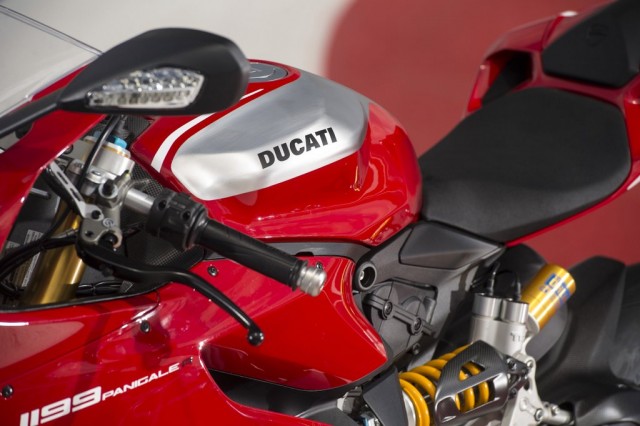 State-of-the-art from the ground-up and melding latest technologies with the latest family features, the 1199
State-of-the-art from the ground-up and melding latest technologies with the latest family features, the 1199
Panigale is totally “Ducati” in every respect. Its no-compromise approach to sport design and stylish
attention to incredibly fine detail presents authentic Italian performance at its purist.
Racing is the platform on which Ducati has always challenged and measured itself. It is a discipline for
designers and engineers and the bedrock of motivation for a company in which the constant desire for
victory has become a way of life. With over 300 World Superbike race wins and more World Championship
titles than all other manufacturers together, Ducati’s focus on sportbikes is stronger than ever.
Ducati combined the innovative “monocoque” frame solution and the extraordinary “Superquadro”
L-twin engine design, with race-derived electronics toproduce the champion of all Superbikes. Bred for the
track and trained for the road, the 1199 Panigale is a true revolution of the species destined to influence the
entire sportsbike environment.
* R version dry weight
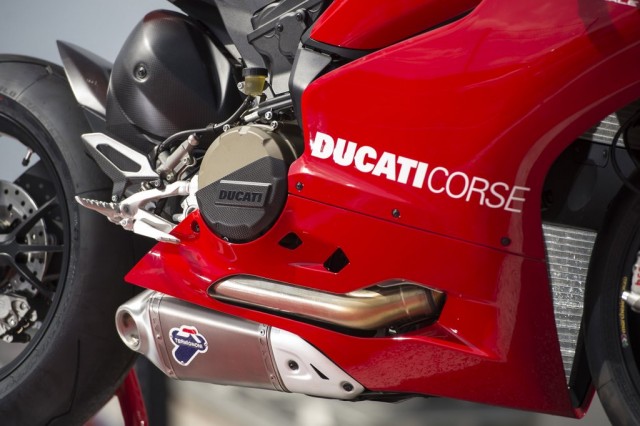 Revolution of the species
Revolution of the species
Designers and engineers of the latest generation Superbike were given a “blank canvas” to reach the
apparently impossible 1199 Panigale targets of 10kg less weight and 25hp more power. Every detail, every
dimension and every design decision was driven entirely by a zero-compromise brief to create the highest
performance Ducati Superbike of all time. The 1199 Panigale set the most extreme benchmark ever and its
arrival represented one of the most historic moments in Ducati’s long Superbike history.
Pronounced “Pan-ee-gah-lee”, the model broke with Ducati’s Superbike tradition by adding a name to its
1199 engine designation and making a significant association to its historic roots in the Borgo Panigale area
of Bologna. In an Italian territory known as “Motor Valley” and where high performance and racing runs
through the veins of its passionate people, Ducati have underlined their pride in being world ambassadors
for the “Made in Italy” title by immortalizing their birthplace in the name of the new Superbike.
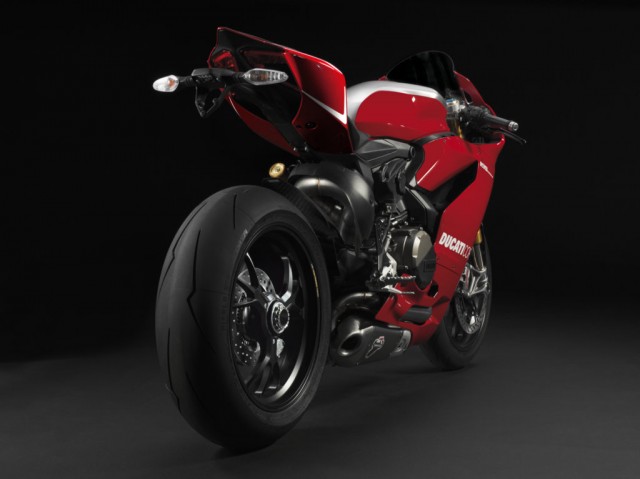 Unmistakably Ducati
Unmistakably Ducati
Every last detail of the 1199 Panigale pays tribute to the rich heritage of racing on which Ducati is built.
Components that are not only functionally efficient, but also minimalist, essential and beautifully engineered
into pieces of automotive art.
Climb aboard the 1199 Panigale and take hold of the bars and the feeling of pure racing is everywhere. The
finely formed top-clamp with weight-saving hollows and recesses immediately communicates Italian
engineering at its very best.
Radial brake and clutch pumps, Ducati’s precise switchgear and full Ride-by-Wire twistgrip give a
race-driven sense of minimalism further enhanced with the monocoque-integral steering head flowing into the
magnesium front sub-frame and Ducati Corse-style instrumentation. Even the lightweight, 17 litre (4.5 gal
US) aluminium fuel tank is sculpted perfectly to the rider.
The horizontal twin headlamps are integrated with the frontal intake ducts, creating a true “race face” for the
Superbike proudly illuminated by motorcycling’s first ever full LED positioning and main light solutions.
Twin rear lights are moulded perfectly around the recessed seat air ducts and illuminate with an attractive
light-guide surround effect, enhanced with LED brake lights. Front LED indicators are integrated into the
mirror bodies and rear indicators, which are also LED*, are styled with clear lenses.
The majority of the frontal air ducts feed the main airbox, while a small splitter also diverts air into the fairing
bodywork to ensure efficient cooling for the onboard electronics. The carefully executed shape at the rear of
the fairing enables a highly efficient exit from the radiator area, protecting the Superquadro’s power output
and further reducing aerodynamic resistance.
The sleek shape of the seat and tail-piece is accentuated by the under-engine location of the exhaust
system, further enhancing the aggressive stance of a true Ducati Superbike.
*Country specific
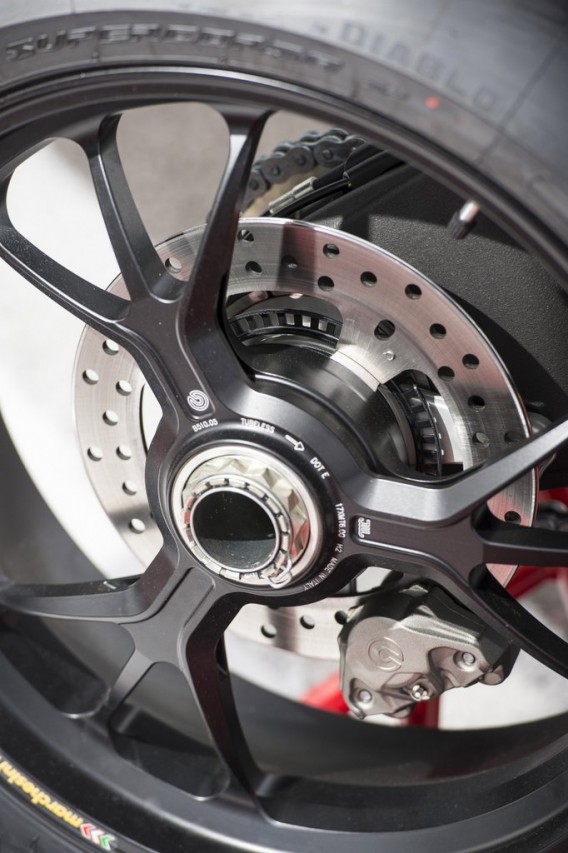 Monocoque technology
Monocoque technology
The 1199 Panigale’s chassis represents Ducati’s innovative and courageous step forward in motorcycle
design, merging multiple parts into one compact and lightweight component. Developed in the super-competitive
racing environment, the extremely compact monocoque construction integrates the airbox to
become one of the key elements in reducing the Superbike’s overall dry weight by an incredible 10kg (22lb)
to a benchmark 165kg* (363.7lb).
Using the Superquadro engine as a stressed member of the chassis, the short and strong aluminium
monocoque is made in die-cast aluminium and is responsible for 5kg (11lb) of the overall weight saving of
the design. The monocoque attaches to the cylinder heads of the specially designed engine, protruding
forward to house the steering head bearings and forming the airbox along the way, which is capped-off and
sealed when the, 17 litre (4.5 gal US) aluminium fuel tank is attached, again using one component to the
fulfil the roles of two.
While the cylinders remain true to Ducati’s signature 90° L-twin configuration, the engine design effectively
rotated the top-end backwards around the crankshaft a further 6° compared to the 1198, giving more
clearance on the front wheel and enabling engineers to modify the front and rear weight bias. This also
enables a front-end geometry of 24.5° of rake and 100mm (3.94in) of trail. Attaching directly to the rear of
the engine, the fully die-cast aluminium, single-sided swingarm with adjustable pivot point enables a
wheelbase of 1,437mm (56.6in) and helps set the weight distribution of the 1199 Panigale at 52% front and
48% rear with average-size rider onboard.
With the exhaust system located below the engine, the die-cast aluminium rear sub-frame is considerably
lighter and also attaches directly to the Superquadro engine, while the super lightweight, magnesium front
sub-frame attaches directly to the monocoque frame, providing secure support for the headlamp,
instrumentation and fairing. This combination of weight saving and centralisation of mass around these high
front and rear sub-frame areas substantially contributes to overall vehicle agility.
* R version dry weight
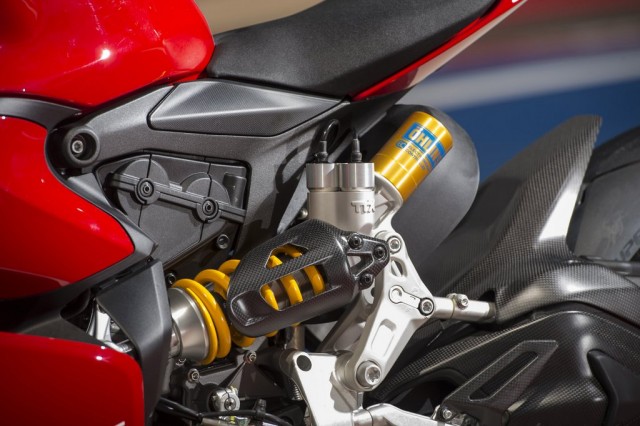 Innovative suspension
Innovative suspension
Incorporating Ducati’s Riding Mode technology, the 1199 Panigale R is fully equipped with front and rear
Ducati Electronic Suspension (DES) system by Öhlins. The 43mm Öhlins NIX30 forks are adjustable
electronically in compression and rebound damping, while spring pre-load is manual. The 1199 Panigale
fork leg centres are set to World Superbike-style widths, enabling uncompromised air-flow to the brake discs
for optimum cooling and an adjustable steering damper completes the full Öhlins package.
The Öhlins TTX36 rear unit features twin tube technology for totally separate damping adjustment in
compression and rebound and to minimise the risk of cavitation under extreme conditions. The unit is fully
adjustable electronically in compression and rebound damping, while spring pre-load is manual.
The electronic suspension adjustment can be made either by using the pre-set Riding Modes, which have
been developed by Ducati test riders and racers, or in independent mode, which allows riders to use their
own personal and saveable settings. Digital damping adjustments send signals that execute the mechanical
adjustment via electronic actuators mounted in the suspension units.
The rear suspension of the Panigale features a stylish and practical side-mounting, enabling increased
space for the rear cylinder head, which has been rotated backwards around the new generation engine. The
unique positioning renders the unit totally accessible for spring pre-load and rider-height adjustment, and is
designed to provide a fast and easy linkage adjustment by simply changing the pushrod fixing-point from
“progressive rate” for road use with a passenger to “flat rate” for track use.
The race-oriented “R” model features a 4-point adjustable swingarm pivot, designed to enable riders a
personalised and precise set-up of varying levels of pro or anti-squat to optimise traction on corner exit. The
settings are dialled-in using two user-friendly eccentric adjusters that offer
pivot positions at +2mm higher, -2mm lower and -4mm lower than the standard position, each positively and accurately locked and located.
The clearly marked, easy-to-use system provides optimum adjustability for competition use.
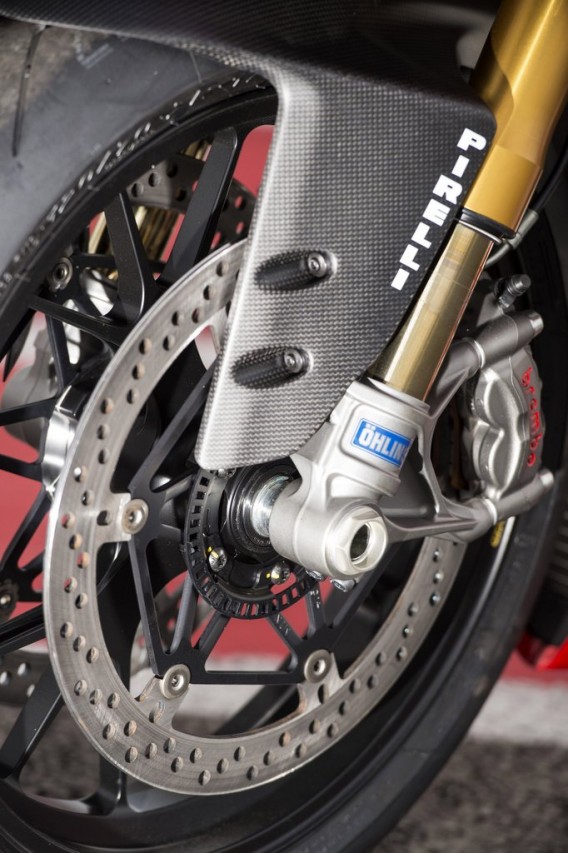 Latest generation brakes
Latest generation brakes
The 1199 Panigale generation of Superbikes use the latest generation of Brembo Monobloc M50 callipers,
presenting a super-compact design that reduced their total unsprung weight by 0.5kg.
Machined from a single piece of alloy, the callipers achieve a higher rigidity and resistance to distortion
during extreme braking. The resulting increase in hydraulic efficiency not only delivers incredible braking
power, but also provides an enhanced and precise “feel” at the brake lever. The twin Monobloc M50
callipers each have four 30mm pistons that grip 330mm discs to achieve spectacular braking performance.
Sport-oriented ABS
The 1199 Panigale R uses the very latest in sport-oriented ABS technology to enable full integration with
Ducati’s three pre-programmed Riding Modes. Operating with the latest generation 9ME Bosch processor,
the system enables full ABS on the front only, when in Race mode, allowing the rider initial braking drift on
the rear during race track corner entry. The system then activates full front and rear ABS, front-to-rear
combined braking (CBS) and “rear lift-up” detection when in Sport and Wet Riding Modes.
Remaining almost undetectable at the lever, these advanced features enable shorter braking distances by
optimising brake force distribution for superior vehicle stability. The advanced ABS, can also be deactivated
via the instrumentation control panel.
Panigale wheels and tyres
The 1199 Panigale R rolls on super lightweight, triple 3-spoke, forged and machined wheels by Marchesini,
in 3.5in front rim width and 6.00in rear, enabling a fast change of direction and enhanced acceleration and
braking performances. Finished in black, the wheels are mounted with Pirelli Diablo Supercorsa SP tyres,
road-going race replicas of the official World Superstock 1000 fitment. While the front uses a 120/70 ZR17,
the 200/55 x ZR17 represents the widest rear tyre ever fitted to a production Ducati Superbike.
Designed for precise line-holding and corner trajectory, the rear 200/55 x ZR17 effectively increases the
contact patch area and speed of lean by combining the 200mm width with a higher profile. Pirelli and Ducati
engineers worked together to create this ideal “match” between front and rear profiles and the results
generate incredible “feel” and directional agility from the new monocoque chassis technology during corner-entry.
The structures and compounds are derived directly from Pirelli’s experience in World Superbike competition.
They present a complex carcass designed for stiffness under heavy braking and shoulder areas that
maximise contact patch, further enhanced with a bi-compound tread laced with new polymers to generate
rapid warm-up and constant grip.
Electronic technology
The 1199 Panigale R is equipped with many of the latest innovative electronics developed by Ducati on the
race track, and they are combined, managed and displayed on full TFT technology instrumentation. First
introduced to the motorcycle industry on the Ducati Diavel, the TFT display is super-enhanced on the 1199
Panigale range.
The state-of-the-art electronics package features an enhanced version of the Ducati Data Analyser (DDA+),
and Ducati Riding Modes, with fully integrated ABS, Ducati Electronic Suspension (DES), Ducati Traction
Control (DTC), Ducati Quick Shift (DQS), Engine Brake Control (EBC), full Ride-by-Wire (RbW) and the Thin
Film Transistor instrumentation (TFT).
The 1199 Panigale R uses a compact Ducati Quick Shift (DQS), and increases its formidable fire power with
a sport-intended, adjustable ABS system and Ducati’s Engine Brake Control system (EBC), designed to
enhance stability during de-acceleration.
 Ducati Riding Modes
Ducati Riding Modes
First introduced in 2010, Ducati’s industry-changing Riding Modes effectively offer the perfect set-up
appropriate to rider and environment by selecting from a choice of three pre-set modes. Each Riding Mode
is pre-programmed to instantly change engine character and suspension set-up in addition to ABS, DTC and
EBC levels – even while riding. The modes are made possible by combining a number of class-leading
technologies.
An electronic Ride-by-Wire (RbW) system – withenhanced calibration for 2013 – administers different
mappings to regulate power delivery, while Ducati Electronic Suspension (DES), by Öhlins, instantly
configures the suspension set-up with electronic adjustment. The Ducati Traction Control system (DTC)
uses eight levels of system interaction to enhance control by reducing wheel-spin and the latest generation
of ABS processor provides ideal anti-lock levels. EBC monitors crankshaft de-acceleration under heavy
braking and administers RbW throttle opening to maintain optimum grip.
Race Riding Mode
The Race Riding Mode provides the track rider with an unrestricted 195hp with direct RbW throttle response
and an instant track-oriented suspension set-up. Racemode also reduces the DTC system intervention,
provides a race-oriented EBC and front-only ABS with reduced anti-rear-lift-up and instantly reconfigures the
instrumentation layout with a track-oriented display.
Sport Riding Mode
The Sport Riding Mode provides the road or track rider with 195hp, delivered with a “smooth” RbW throttle
response and a sport-oriented suspension set-up. Sport mode slightly increases the DTC system
intervention, provides a sport-oriented EBC and front and rear ABS with increased anti-rear-lift-up.
Wet Riding Mode
The Wet Riding Mode provides the road or track rider with 120hp, delivered with a “smooth” RbW throttle
response, increased DTC system intervention, environment-appropriate EBC, DQS off and fully enhanced
ABS and a suspension set-up optimised for low grip conditions.
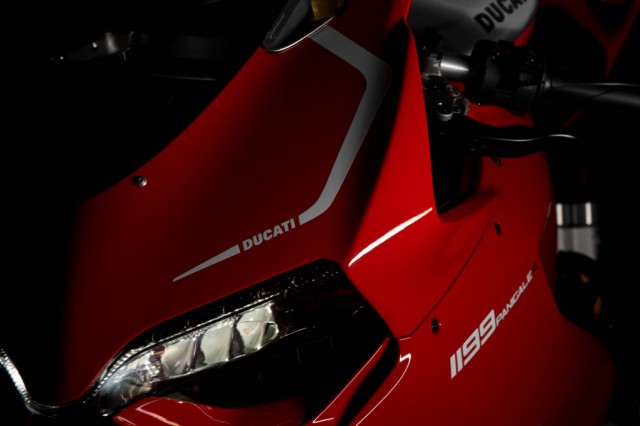 Thin Film Transistor instrumentation (TFT)
Thin Film Transistor instrumentation (TFT)
The 1199 Panigale’s instrumentation uses Ducati’s industry-leading Thin Film Transistor (TFT) screen unit
that embraces the very latest information display technology. The full colour display automatically changes
its layout according to the Riding Mode selected in order to provide optimum clarity of information
appropriate to the motorcycle’s environment, even reversing its character and
background colours in low-light conditions. For the 1199 Panigale R a number of display changes have been programmed to manage
the higher rev-limit.
The high-definition instrumentation displays RPM from 1000-12,500 in a scale that curves through 90°
around the left and upper edge of the main screen, incrementally adding bars of light around the display as
the engine speed increases, while enlarging each of the main 1-12 numbers in the scale as each value is
reached. During the first 1000km running-in period, the “orange section” of the rev-range automatically
moves down from its normal 10,500 lower level to 6,000rpm. When the running-in period is completed, the
orange section automatically returns to its 11,000-12,000rpm range, although during each engine warm-up,
it is programmed to start from 8,000rpm, increasing to 9,000 and finally to its normal 11,000rpm position
when the engine reaches normal working temperature. Along the bottom of the screen from left to right, is
the current status and/or setting of Riding Mode, ABS, DTC, DQS and EBC and on the right of the screen,
an easy-to-read gear indicator displaying from N to 6 with the top left corner of the screen displaying the
time.
In “Road” and “Wet” Riding Modes the vehicle speed takes precedence in the centre of the display with
large numerals, while two framed “additional information” panels, situated below, present total mileage by
default on the left and engine coolant temperature on the right. Both left and right readings are scrollable
while riding to read trip 1, trip 2 and fuel reserve trip on the left info frame with the scroll-up button on the
switchgear. Actual and average fuel consumption, average speed, journey time and air temperature appear
on the right info frame with the scroll-down button.
In “Race” Riding Mode, the display automatically reconfigures by re-scaling the RPM read-out, moving the
lesser important vehicle speed to the lower left info frame and making way for the latest lap time to be
displayed large in the centre of the screen. When actuated, the lap time facility is triggered manually by
using the flasher button on the switchgear or automatically with the GPS equipped DDA+.
When the 1199 Panigale R is stationary, the instrumentation is also used as a user-friendly control panel to
personalise ABS, EBC, DES, DTC, DQS, and RbW settings within each Riding Mode before saving. In
addition to listing the last 30 recorded lap times, each time also shows the lap number and the maximum
speed and maximum rpm recorded during that lap.
Fixed icons on the left of the main screen from top to bottom show warnings for left turn signal, main beam,
ABS-off and neutral, while from top to bottom on the right of the display are turn signal right, oil pressure,
fuel reserve and engine electronics. Countdown icons are programmed to appear on the screen to advise of
upcoming scheduled maintenance. A strip of red lights rising on the right and left outer edges and across the
top of the instrumentation illuminate incrementally upwards to warn of over-rev. The first 25% at 11,000rpm,
50% at 11,200rpm, 75% at 11,400rpm and 100% as both strips meet and the top centre bar starts to flash.
Below the top, centre over-rev bar is a second bar that illuminates in orange during DTC interaction.
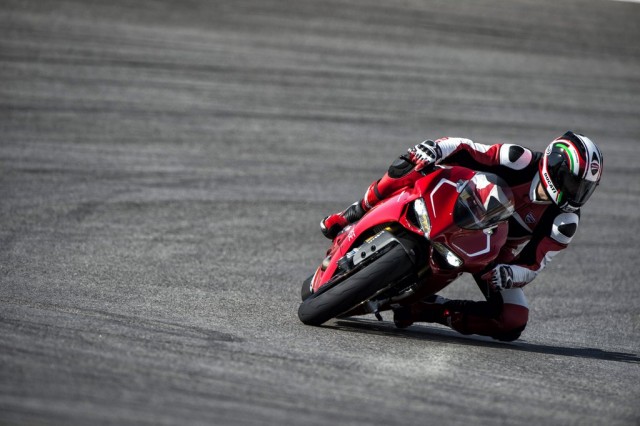 Ducati Data Analyser+ (DDA+)
Ducati Data Analyser+ (DDA+)
The Ducati Data Analyser (DDA) consists of a software download and a USB-ready data retrieval card and
evaluates the performances of the motorcycle and its rider by graphically presenting specific channels of
information.
DDA+ is the latest generation of the system and introduces a GPS function that automatically
records lap-times every time the 1199 Panigale R crosses a circuit start/finish line. As the rider crosses the start and
finish line and presses the lights flasher button, the innovative system logs the coordinates of that position
and then automatically logs each lap time as the motorcycle completes subsequent laps.
An essential piece of equipment for the circuit, DDA records numerous channels of data including throttle
opening, vehicle speed, engine rpm, gear selected, engine temperature, distance travelled, laps and lap
times. An additional channel of information is also dedicated to recording the DTC index which can then be
viewed as a graphic trace indicating the amount of DTC interaction during wheel-spin. At the end of a ride or
track session, data can be downloaded ready to compare, analyse and get an inside view of the
performance of the rider and motorcycle.
 Ducati Electronic Suspension (DES)
Ducati Electronic Suspension (DES)
The 1199 Panigale R is equipped with Öhlins suspension and features the innovative Ducati Electronic
Suspension (DES). The technology enables front and rear rebound and compression damping adjustments
to be controlled automatically by using the pre-set Riding Modes or in independent mode, allowing riders to
use their own personal and saveable settings. Digital damping adjustments made via the instrumentation
send signals that execute the mechanical adjustment via electronic actuators mounted inside the
suspension units.
Ducati Traction Control (DTC)
Ducati’s highly successful DTC system has been refined for the 1199 Panigale range and fully integrated
into the electronics package of all versions. It uses the same software logic developed and used by Ducati
Corse for their MotoGP and World Superbike motorcycles and offers a choice of eight settings developed by
a team of professional test riders and racers.
Accessible from the left-hand switchgear and displayed on the TFT instrumentation, the system offers a
choice of eight profiles, each one programmed with a wheel-spin tolerance graded from one to eight. While
level eight administers a confidence-building, high level of interaction from the system by activating upon the
slightest detection of wheel-spin, level one offers a much higher tolerance and so reduced intervention for
highly competent riders. The DTC system status and level is constantly displayed on the instrumentation,
reminding the rider of the current interaction level if the Riding Modes is changed.
When the level that best suits the combination of road or track conditions and riding style has been selected
and the DTC system activated, front and rear wheel sensors compare speed differential to sense when rear
traction is being broken (wheel-spin). DTC then decides the best combination of two different types of
instant electronic adjustment, calculated with data supplied from multiple sources. The first ‘soft’ stage of
system interaction is executed by high speed software that makes instant electronic adjustment to the
ignition timing, administering varying amounts of ignition retardation to reduce the engine’s torque. If the
DTC software detects that the first ‘soft’ stage of system interaction is inadequate to control the wheel-spin,
it continues to administer ignition retardation and, in addition, instructs the engine ECU to initiate a pattern of
constantly increasing injection cuts until, if necessary, full injection cut.
During both stages of system interaction, an orange warning light, which is visible in the rider’s peripheral
vision and situated across the top of the instrumentation, illuminates to signify that DTC is being used. As
soon as the system recognises the gradual return of equal wheel speeds, it incrementally re-establishes
normal power delivery. This seamless interaction iskey to the super-smooth operation of the system.
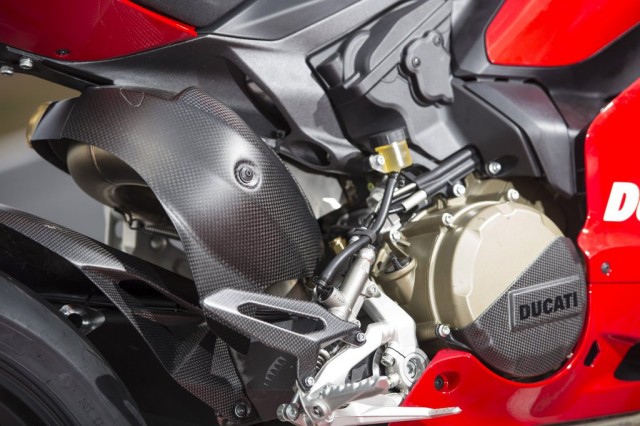 Ducati Quick Shift (DQS)
Ducati Quick Shift (DQS)
The Ducati Quick Shift (DQS) system, allows the rider to keep the throttle open when changing-up through
the gearbox, helping to save vital fractions of a second in the pursuit of faster lap-times. The system not only
saves time when changing gear, but also enables the possibility of uninterrupted air flow through the throttle
bodies throughout the upward gear-changing process.
The system consists of a micro-switch built into the linkage of the gear change lever, which when actuated
in the direction of selecting a higher gear, sends a signal to the main ECU. The ECU instantly understands
which gear the motorcycle is in by calculating the rpm and vehicle speed and then reads the amount of
throttle opening before applying a pre-programmed cut in fuel injection and ignition measured in
milliseconds. This spilt-second electronic interruption in drive is programmed precisely to allow the next gear
to be selected without having to actuate the clutch or close the throttle. As the system only functions for a
matter of milliseconds, the 1199 Panigale can still be ridden using a normal gear-changing style.
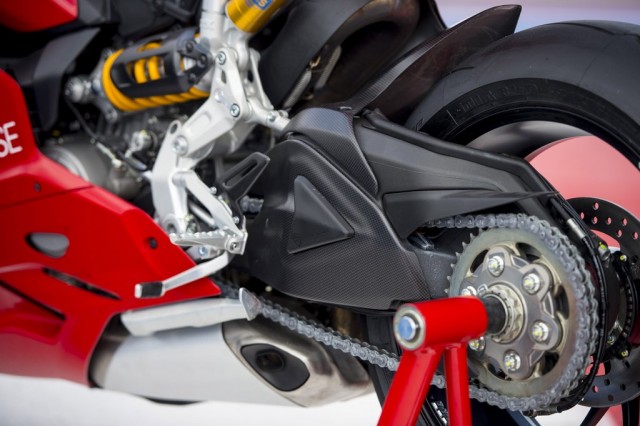 Engine Brake Control (EBC)
Engine Brake Control (EBC)
The “Engine Brake Control” (EBC) system was developed by Ducati Corse to help riders optimise vehicle
stability under extreme corner-entry racing conditions by equalising the positive and negative forces of
torque subjected to the rear tyre under severe engine-braking conditions. EBC monitors throttle position,
gear selected and crankshaft de-acceleration rate under heavy braking and administers precise RbW
throttle openings to balance the torque forces acting on the tyre. EBC has a three level operating system
accessible from the instrumentation and is integrated automatically into its three Riding Modes to provide an
additional and highly effective rider aid.
The “Superquadro” power house
Ducati’s no-compromise approach to design has set the most extreme twin-cylinder benchmark ever and the
Superquadro represents the latest milestone in Ducati’s long and iconic history of Superbike engines.
The innovative Superquadro engine, so called because of its massively over-square bore and stroke ratio,
increased power to an absolute production twin-cylinder milestone of 195hp and torque to 98.1 lb-ft
(13.5kgm) with user-friendly Riding Modes that deliver power appropriate to the rider’s style and
environment. Its construction has enabled a radical reduction in overall vehicle weight and, further
identifying Ducati’s constant pursuit of performance perfection, major services have been extended to
24,000km (15,000 miles).
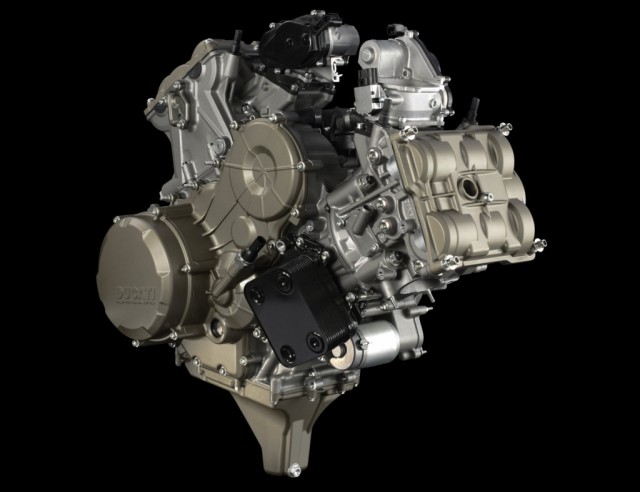 Engine architecture
Engine architecture
With the engine designed to be a fully stressed member of the chassis, its architecture has been completely
re-calculated to provide the best possible vehicle construction for layout, weight distribution and strength.
The cylinders, which remain at 90° to each other, were effectively rotated backwards around the crankcases
by 6°, until the front cylinder were 21° from horizontal. This enabled the engine to be positioned 32mm
further forwards for improved front / rear weight distribution in addition to perfectly positioning the cylinder
head attachment points for the Panigale’s monocoque frame.
The crankcases, which are vacuum die-cast using Vacural® technology to ensure optimal weight saving,
consistent wall thickness and increased strength, also incorporate the outer water-jacket of the “cylinder”,
eliminating the jointing face that used to exist at the base of the cylinders. Instead, the Superquadro has
separate nikasil-coated aluminium “wet-liners” inserted into the tops of the crankcase apertures. This design
enables secure fixing of the cylinder head directly to the crankcase, improved sealing and enhanced heat
dissipation from the thin cylinder-liners directly into the surrounding coolant.
The primary-drive casing, clutch casing and outer cover, sump and cam covers are all cast in magnesium
alloy, ensuring a lightweight engine despite its increased strength as an integral part of the chassis.
The crankcases use shell main bearings for the crankshaft, enabling an increase in diameter of the crank
journals for enhanced rigidity and an increase of the crankcase section around the main bearing area for
improved strength in line with the Superquadro’s extreme power output. For 2013, the new 1199 Panigale R
goes one step further with the introduction of titanium con-rods, which save 0.63kg (1.38lb) and a new,
lightweight crankshaft flywheel, saving a further 0.7kg (1.54lb). This reduction in weight and increase in
strength now enables a 500rpm higher rev-limit to 12,000rpm. The shell bearings are force-fed oil from
internal drillings within the main bearing pillars to keep the crankshaft well lubricated and is quickly
scavenged back into the sump with the introduction of a highly efficient GP-style vacuum pump.
The pump is driven by the main oil pump shaft and effectively maintains constant vacuum in the crankcase
area below the pistons, reducing atmospheric resistance during the down-stroke of the piston and controlling
the internal “breathing” of the engine.
 Extreme dimensions
Extreme dimensions
In calculating the optimum configuration for the big step forward in power output for the L-twin engine,
Ducati and Ducati Corse engineers increased engine speed and enhanced breathability with the incredible
bore and stroke of 112mm x 60.8mm (4.40×2.39in). The intense study of power and ridability resulted in an
output of 195hp @ 10,750rpm and 98.1 lb-ft (13.5kgm) @ 9,000rpm. The bore and stroke ratio of 1.84:1
effectively increases rpm with the ultra-short stroke of the crankshaft and increases the cylinder area to
enable valves diameters of 46.8mm (1.71-1.84in)for inlets and 38.2mm (1.35-1.5in) exhaust.
With such large inlet valves operating at higher rpm, the intense inertial forces have been controlled by
using titanium instead of steel. The valves are actuated by, ‘super-finished’ rocker arms for reduced friction
and fatigue and then coated in and diamond-like carbon (DLC) on the new 1199 Panigale R.
The race-derived Superquadro pistons have a distinctive double-ribbed undercrown to achieve high strength
and reduced friction by using minimal piston wall surface area. Using technology developed by Ducati
Corse, the design enables reliable operation of the 112mm diameter pistons when performing at high rpm.
The improved volumetric efficiency of the increased inlet valve diameters is further capitalised on by
increasing the oval throttle body dimensions from an equivalent diameter of 63.9 to a massive and
high-flowing 67.5mm (2.66in). The Ride-by-Wire throttle bodies feed air across twin injectors per cylinder, one
positioned below the butterfly for enhanced flexibility and one above for outright power.
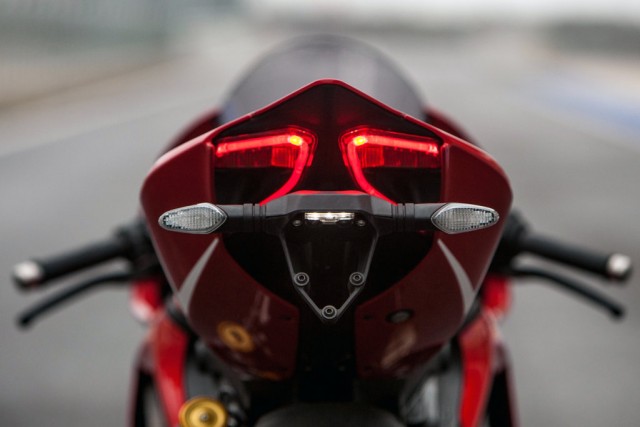 Clean power
Clean power
With such enhanced “breathing”, the challenge for the Superquadro’s design engineers was to program
performance-optimised fuel mapping for a smoother cycle-to-cycle engine operation, without compromising
emissions. To achieve this, Ducati introduced a secondaryair system that completes the oxidisation of
unburned hydrocarbons and effectively reduces HC and CO levels. The system is activated when the
engine ECU recognises specific conditions in the engine’s operation via the lambda and throttle opening
sensors. It then opens a valve enabling a flow of clean air from the main airbox to a reed valve situated in
each cylinder head, which enables one-way flow into an air gallery exiting into the exhaust port close to the
exhaust valve. Entering the hottest point of the exhaust gasses, the fresh charge of air enhances the burn
environment, eliminating any unburned fuel that escapes during the exhaust cycle under certain conditions.
Desmo dependent
Never before has Ducati’s unique Desmodromic system been so vitally important. With the high engine
speeds at which the Superquadro operates combined with such large valves, it would be impossible for the
valve’s rocker-arm to follow the steep closure profile of the cam lobe using normal valve closure springs.
The Desmo system actuates valve closure mechanically with the same method and accuracy as it opens,
enabling steep cam profiles, radical cam timings, large valves and high operating speeds. This system is
used on every single Ducati motorcycle and is constantly proven on Ducati Corse’s World Superbikes and
Desmosedici GP bikes.
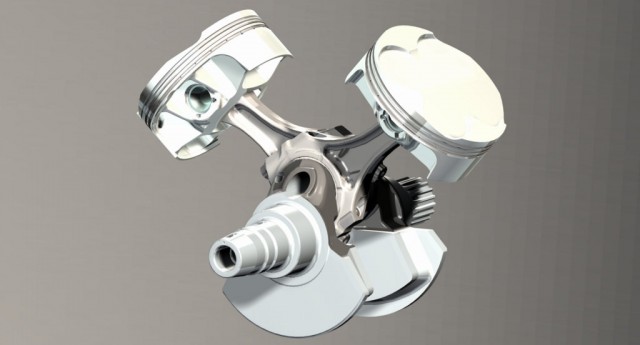 The power of precision
The power of precision
The large valves and precise Desmodromic systemare driven by a combined chain and gear-drive
arrangement. The conventional bush-type chain runs from the crankshaft to the cylinder head where a
single sprocket positioned between inlet and exhaust camshafts, is attached back-to-back to a gear wheel
mounted on its own short, dedicated shaft. The attached gear meshes directly with gears on the ends of
both the inlet and exhaust camshafts, which are also designed with +/- position adjustment for ultra-precise
cam-calibration. The cam chain, therefore, provides highly efficient point-to-point drive route and, tensioned
automatically, provides continuous reliability, further reducing the cost of routine maintenance.
On the end of each exhaust cam drive gear is a centrifugal flyweight which retracts at speeds below tick-over to rotate a “protrusion” from the concentric section of the cam, thus creating sufficient valve lift to act as
a de-compressor. This ingenious device enables the Superquadro engine to be started easily without using
a larger battery and starter motor, which helped reduce overall vehicle weight by approximately 3.3kg
(7.3lb). When the engine starts and the camshafts begin to rotate at tick-over speed, the centrifugal
flyweight flicks out, retracting the “protrusion” back into the cam and allowing complete valve closure for full
compression. This innovative feature further underlines the lengths to which designers and engineers have
worked together in the single-minded pursuit of weight-saving.
Transmission
The Panigale is the first top-of-the-range Ducati Superbike to use a “wet”, oil-bath clutch. Based very closely
on the design of the Multistrada and Diavel components, the clutch assembly features a “slipper” function
and a progressive self-servo mechanism that compresses the friction plates when under drive from the
engine. While enhancing frictional efficiency, this also results in a rider-friendly light clutch lever “feel” at the
handlebar. Conversely, when the drive force is reversed (over-run), the mechanism reduces pressure on the
friction plates, enabling a true racing “slipper” action, reducing the destabilizing effect of the rear-end under
aggressive down-shifting.
R extras
1199 Panigale R
•As “S” version with:
oDucati red with white racing features colour scheme
oLightweight titanium con-rods
oLightweight crankshaft flywheel
oDLC-coated rocker-arms
oIncreased rev-limit (12,000rpm)
o15/41 Final drive
o4-point adjustable swingarm pivot
oCarbon fibre:
Single-sided swingarm protector
Clutch cover protector
Rear hugger
Rear suspension guard
Footrest heel guards
Ignition switch surround
Top fairing inner panels
oRace kit:
Full Termignoni exhaust system
Up-map key with dedicated ECU mapping
High-penetration racing screen
Fairing mirror-caps

